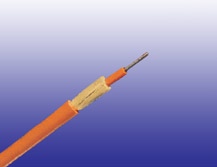|
Caledonian fireflix Cables
CABLE CONSTRUCTION
fireflix cables are constructed in the following typical design:
1. Solid/stranded annealed copper conductor
2. Glass mica tape/silicone rubber as flame barrier
3. XLPE/silicone rubber as insulation
4. LSZH/Flame retardant RPVC as sheath
fireflix cables are offered in either single core, multicore or multi-pair constructions.
The insulation material can be elastomeric (EPR, SR), thermosetting (XLPE, LSZH) or thermoplastic (EVA, LSZH) to meet different stringent environment requirement. The cables may be armoured or braided, with or without metallic screen, depending on different applications.
INTERNATIONAL STANDARD
The fireflix cables manufactured by Caledonian comply with either one or combination of the following standards.
BS 6387
IEC 60331
IEC 60332-1
IEC 60332-3C
IEC 61034-1/2
IEC 60754-1
|
|
|
PRODUCTS
Fire Resistant Optic Fiber Cables
Fire resistant Central Loose Tube Fiber Optic cables
Application
These cables are characterized by light weight and small diameter, suitable for both aerial and duct installation. They are mainly installed inside buildings, tunnels,subways or closed areas in general, specially designed to guarantee the signal transmission even in case of fire. The cable can also be used for direct burial for armoured version.
Standards
Basic design to Telcordia GR-20 / RUS 7 CFR 1755.900 (REA PE-90) / ICEA S 87-640
FIRE PERFORMANCE
Circuit Integrity |
IEC 60331-25; BS 6387 CWZ; DIN VDE 0472-814(FE180);
CEI 20-36/2-1; SS229-1; NBN C 30-004 (cat. F3);
NF C32-070-2.3(CR1)
|
System circuit integrity |
DIN 4102-12, E30 depending on lay system |
Flame Retardance (Single Vertical Wire Test) |
EN 60332-1-2; IEC 60332-1-2; BS EN 60332-1-2; VDE 0482-332-1 ; NBN C 30-004 (cat. F1); NF C32-070-2.1(C2);
CEI 20-35/1-2; EN 50265-2-1*; DIN VDE 0482-265-2-1*
|
Reduced Fire Propagation (Vertically-mounted bundled wires & cable test) |
EN 60332-3-24 (cat. C); IEC 60332-3-24; BS EN 60332-3-24; VDE 0482-332-3; NBN C 30-004 (cat. F2); NF C32-070-2.2(C1); CEI 20-22/3-4; EN 50266-2-4*; DIN VDE 0482-266-2-4 |
Halogen Free |
IEC 60754-1; EN 50267-2-1; DIN VDE 0482-267-2-1;
CEI 20-37/2-1 ; BS 6425-1*
|
No Corrosive Gas Emission |
IEC 60754-2; EN 50267-2-2; DIN VDE 0482-267-2-2;
CEI 20-37/2-2 ; BS 6425-2*
|
Minimum Smoke Emission |
IEC 61034-1&2; EN 61034 -1&2; DIN VDE 0482-1034-1&2;
CEI 20-37/3-1&2; EN 50268-1&2*; BS 7622-1&2*
|
No Toxic gases |
NES 02-713; NF C 20-454 |
Note: Asterisk * denotes superseded standard.
CABLE CONSTRUCTION
Fibers: Singlemode and multimode fibers, with loose tube technology.
Structure: Central loose tube cable contains one tube with 2-24 single or multimode fibers, which are filled with water blocking gel.
Fire barrier: The jelly filled tube with up to 24 fibers is wrapped with a fire blocking mica glass tapes.
Water blocking: The jelly filled tube is waterblocked by using swellable tape and thread.
Reinforcement: Either aramid yarn or fiber glass is wound around the tube to provide physical protection and tensile strength, with added fire protection.
Inner sheath (optional): The cable can be jacketed with either PE or thermoplastic LSZH inner sheath. PE is the preferred option in outdoor environment for water protection purpose.
Moisture Barrier Tape (optional): An aluminum moisture tape can be incorporated under the sheath for water blocking and shielding purpose.
Armouring(optional):
For diect burial, either galvanized steel wire braid, corrugated steel tape armour or galvanized steel wire armour is applied over an inner polyethylene or LSZH sheath. For steel tape armour, the 0.15mm thick steel tape is coated with a copolymer and applied with an overlap. For steel wire braid or armour, single layer of galvanized steel wire braid or armour is applied.
Ripcord (optional): An optional ripcord can be located under the jacket to facilitate jacket removal.
Outer Sheath: Thermoplastic LSZH compound type LTS3 as per BS 7655-6.1(Thermosetting LSZH compound type SW2-SW4 as per BS 7655-2.6 can be offered.)

Download details in PDF
Download details in Word
|
|